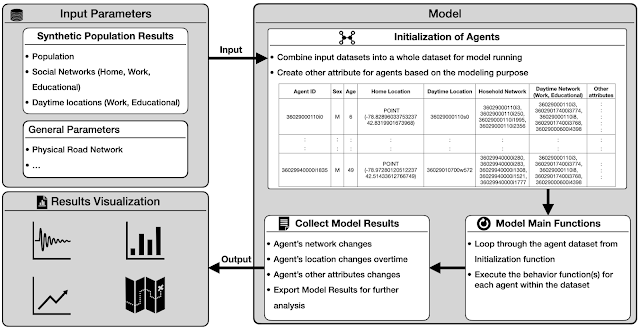
Often we are building geographically explicit agent-based models we spend a lot of time creating the synthetic population to instantiate our artificial world. We have tired to overcome this with creating methods to generate such populations (
see this old blog post). Building on this work,
Na (Richard) Jiang,
Fuzhen Yin,
Boyu Wang and myself have a new paper entitled "Geographically-Explicit Synthetic Populations for Agent-based Models: A Gallery of Applications" which was presented at
2023 Computational Social Science Society of the Americas conference. In the paper we extend the synthetic population to the whole of New York state. While at the same time we introduce a pipeline for using the population datasets for model initialization. To show this pipeline, we present several case studies utilizing Python and
Mesa. These models range from that of commuting to disease spread and vaccination uptake. If this sounds of interest, below we provide the abstract to the paper along with some of the key figures including our pipeline and example applications. At the bottom of the page we provide the full reference and a link to the paper which has links to the models and data.
Abstract: Over the last two decades, there has been a growth in the applications of geographically-explicit agent-based models. One thing such models have in common is the creation of synthetic populations to initialize the artificial worlds in which the agents inhabit. One challenge such models face is that it is often difficult to create reusable geographically-explicit synthetic populations with social networks. In this paper, we introduce a Python based method that generates a reusable geographically-explicit synthetic population dataset along with its social networks. In addition, we present a pipeline for using the population datasets for model initialization. With this pipeline, multiple spatial and temporal scales of geographically-explicit agent-based models are presented focusing on Western New York. Such models not only demonstrate the utility of our synthetic population on commuting patterns but also how social networks can impact the simulation of disease spread and vaccination uptake. By doing so, this pipeline could benefit any modeler wishing to reuse synthetic populations with realistic geographic locations and social networks.
Keywords: Agent-Based Model, Geographically-Explicit Agent-Based Models, Synthetic Population, Python, Mesa.
 |
| Pipeline of Utilizing Synthetic Population Resulting Datasets in Agent-Based Models. |
 |
| Large Scale Disease Spread Model Structure. |
 |
| Disease Dynamics for Two Diseases. |
 |
| Vaccination Opinion Dynamic Model. |
 |
| Simulation Vaccination Rate v.s. Real Vaccination Records: (A) All Population; (B) Different Age Groups of Population. |
Full Referece:
Jiang, N., Crooks, A.T., Yin, F. and Wang B. (2023), Geographically-Explicit Synthetic Populations for Agent-based Models: A Gallery of Applications, Proceedings of the 2023 Conference of The Computational Social Science Society of the Americas, Santa Fe, NM. (pdf)







No comments:
Post a Comment